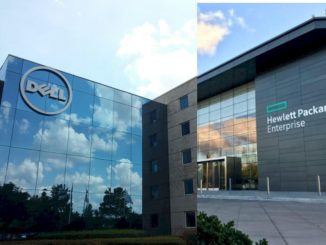
It takes a lot of engineering talent, time, and money to create custom interconnects that are the basis of scale-up servers, which is one of the reasons that so few companies have been able to sustain that investment over the years. Both Hewlett-Packard Enterprise and SGI have decades of experience with their respective interconnects and are both chasing customers who want big memory machines, but that doesn’t mean they always have to compete.
In fact, HPE admits that it has a gap in its product line, and one that it could fill with a bit of engineering work or by employing Intel’s own glueless chipsets for its high-end Xeon E7 family of processors. Out of the box and without any extra work, any Intel OEM partner can create a system with four or eight sockets of the Xeon E7 processors. But, as it turns out, SGI already has such a machine in its UltraViolet 300 series that is based on its own NUMALink 7 interconnect and – perhaps most importantly – it is already certified to run Linux as well as some of the databases that some HPE customers want to run on boxes that are bigger than the four-socket ProLiant DL580 Gen9 server that sits at the top of the company’s industry standard server line.
And so, HPE and SGI have struck up a partnership that will see the world’s largest server maker reselling an eight-socket UV300 system as the Integrity MC990 X system in its own product line. This is one of those deals that is going to help both companies at the same time, a rare thing indeed.
Chasing DB2 And Oracle, Racing For HANA
For both HPE and SGI, the key driver for scale-up machines is database, and particularly in-memory databases like SAP HANA or the in-memory extensions to popular relational databases such as Oracle 12c, IBM DB2, and Microsoft SQL Server.
SGI staked the growth of its UV line on SAP HANA a few years back when it reanimated its all-to-all NUMA servers, called the UV300 series, which tightly couple processors together using the NUMALink interconnect. With the UV3000 series, which was launched last summer using the NUMALink 6 interconnect, SGI offers the more scaled up topologies that are necessary to support the larger numbers of processor cores and slightly bigger main memories, which are required for certain kinds of modeling and simulation workloads in the traditional HPC market. Databases do not like large latencies between clustered server nodes, and that is why the UV300 series uses the faster NUMALink 7 interconnect and limits the scalability to 32 processor sockets based on Intel’s “Haswell” Xeon E7-8800 v3 processors.
SGI reckons that SAP HANA alone will drive a $1 billion opportunity by 2018 for scale-up machines like those from HPE and SGI, which is why Dell partnered with SGI to resell the entire UV300 line back in July of last year. Dell has shown no interest whatsoever in creating its own chipsets or even selling anything larger than a four-socket machine based on the Xeon E7 chips. The volumes are low for scale up machines, and the SGI partnership gives Dell something to sell against those that are selling eight-socket machines based on the Intel Xeon E7 glueless chipsets – that would be Lenovo, Hitachi, Fujitsu, and NEC among the top OEMs – as well as a scale-up machine that it can sell against HPE’s “DragonHawk” Superdome X system, which uses a chipset designed for Integrity Itanium-based systems to scale up a Xeon E7 system to 16 processor sockets and 24 TB of main memory in a single system image. IBM is also in the hunt with its Power8 machines, which scale up to 16 sockets and which recently had their main memory doubled up, and so are Fujitsu and Oracle with their respective Sparc64 and Sparc M7 systems, which offer even more scale.
The last time HPE did an eight-socket server chipset of its own for Xeon E7-class machines was with the ProLiant DL980, which was based on the “Nehalem” and “Westmere” Xeon E7 processors and are looking a bit long in the tooth these days. Jeff Kyle, director of product management for enterprise servers at HPE, tells The Next Platform that doing a deal with SGI to offer a more scalable eight-socket machine aimed at database workloads was in keeping with HPE’s mission to offer the right technology at the right time at the right price, and it didn’t hurt that the SGI UV machines come in a rack form factor that is more compact than the Superdome X, which has a set of reliability features drawn from the Superdome family that are not as necessary for a standalone database server. Kyle says, for instance, that the partitioning technologies in the Superdome X are not necessary for customers wanting to deploy an eight-socket database server, whether it is for Oracle, DB2, or HANA. The SGI UV300 series and the rebadged machine sold as the Integrity MC990 X only support Linux operating systems at the moment, so officially, Microsoft SQL Server, which only runs on Windows Server, is not supported. (You can load up the OpenStack cloud controller and the KVM hypervisor on SGI boxes and then put Windows Server on it, however, as we recently showed. This is not officially supported, however.)
While Windows is supported on the Superdome X machine alongside of Linux, Kyle says that over 80 percent of the sales of the ProLiant DL980 were driven by the combination of Linux and Oracle databases, so not supporting Windows on the SGI machine is not that big of a deal. If customers need Windows on an eight-socket machine, they can always go with Superdome X.
With this deal, HPE is going after business that Lenovo, using the former System x line from IBM, has been aggressively pursuing, according to Kyle, in the eight socket space. With the Integrity MC990 X, an eight-socket machine from HPE is only moderately more expensive than a four-socket ProLiant DL580 – about 5 percent more than twice the price, which is reasonable. But a half-filled DragonHawk Superdome X machine, thanks to its redundant fabrics and nPar partitioning, carries a somewhat higher premium, something on the order of 35 percent more than twice the price of the ProLiant DL580.
Clearly, the Superdome X is design for customers who know they are going to scale and the ProLiant DL580 and now the Integrity MC990 X are made for customers who know they are not. You always pay for scalability because those electronics to glue chips together and indeed, the very processors from Intel itself, cost more.
The Superdome X machines launched in December 2014, and Kyle says that about half of the revenues from the product line are driven by SAP HANA. HPE is also seeing traction with the machines as replacements for big Oracle database clusters, helping customers move from parallel Exadata machines to a shared memory model and therefore getting rid of the Oracle Real Application Clusters (RAC) software licenses in the machine. We suspect that a big chunk of the sales of the Superdome X are for companies using Itanium-based Superdome machines that are migrating from HP-UX to either Linux or Windows, but who want familiar hardware and management software. (That was one of the design goals for Superdome X, after all.)
For SGI, the reseller agreement puts it on its path of increasing sales of the UV product line. SGI president and CEO, Jorge Titinger, reiterated the company’s goal to have at least 10 percent of its revenues in fiscal 2016, which ends this summer, come from the UV product line. In its fiscal 2015 year, less than 5 percent of its revenues came from the UV products, but to grow, it needs to rely on partners and resellers. The high-end UV 2000s and 3000s will grow more or less at pace with the traditional HPC market, around 5 percent to 7 percent per year, but the data analytics part of the business, embodied by the UV 300 series, is growing at more than 20 percent per year, driven by SAP HANA and other in-memory workloads.
“We could not grow our salesforce organically at that rate,” says Titinger, and hence the partnerships with Dell and HPE are crucial to its growth. In the quarter ended in January, Titinger adds, SGI did $10 million in business from the UV 300 series, a run rate of $40 million annualized and triple-digit growth from the year-ago figures. The Dell and HPE deals are non-exclusive, so SGI is on the hunt for more partners, particularly in parts of the globe where it does not have as much reach and others do.
Kyle says that the Superdome X is the market leader, by far, for SAP HANA and that its performance and resilience beats anything out there. Moreover, Kyle says that Superdome X has more certified configurations for SAP HANA than any other players in the market. And this is why HPE does not need to embrace the full SGI UV300 line and is only selling the eight-socket machine.
While HPE is not officially supporting larger Integrity MC990 X machines based on the SGI NUMALink clustering, the company may find that customers compel it to over the long haul – as well as competition with Dell, for that matter. Companies that start with an eight-socket MC990 X machine may not like the prospect of changing over to a whole different architecture when having to double up their processing and memory, as they would have to do with Superdome X. Moreover, they may want to scale up further to 32 sockets at some point or at least know they have the headroom to do so, and thus far the Superdome X is capped at 16 sockets, even though the Superdome architecture can push to 32 sockets and higher, as we know.
The Integrity MC990 X machine will be available this month from HPE. The machine supports Xeon E7 v3 processors with from 4 to 18 cores, topping out at 144 cores with the top-bin Intel parts. With its 192 memory slots across two server enclosures, the MC990 X can support up to 6 TB of memory. The system has 1.8 inch SATA boot drives and four 2.5-inch drive bays for storage and clearly will link out to real storage on the network. Red Hat Enterprise Linux 6 and 7, SUSE Linux Server 11 and 12, and Oracle Linux 7 are all supported on the machine.





Is by that HPE admit the failure for their HPE Integrity Superdome X system?